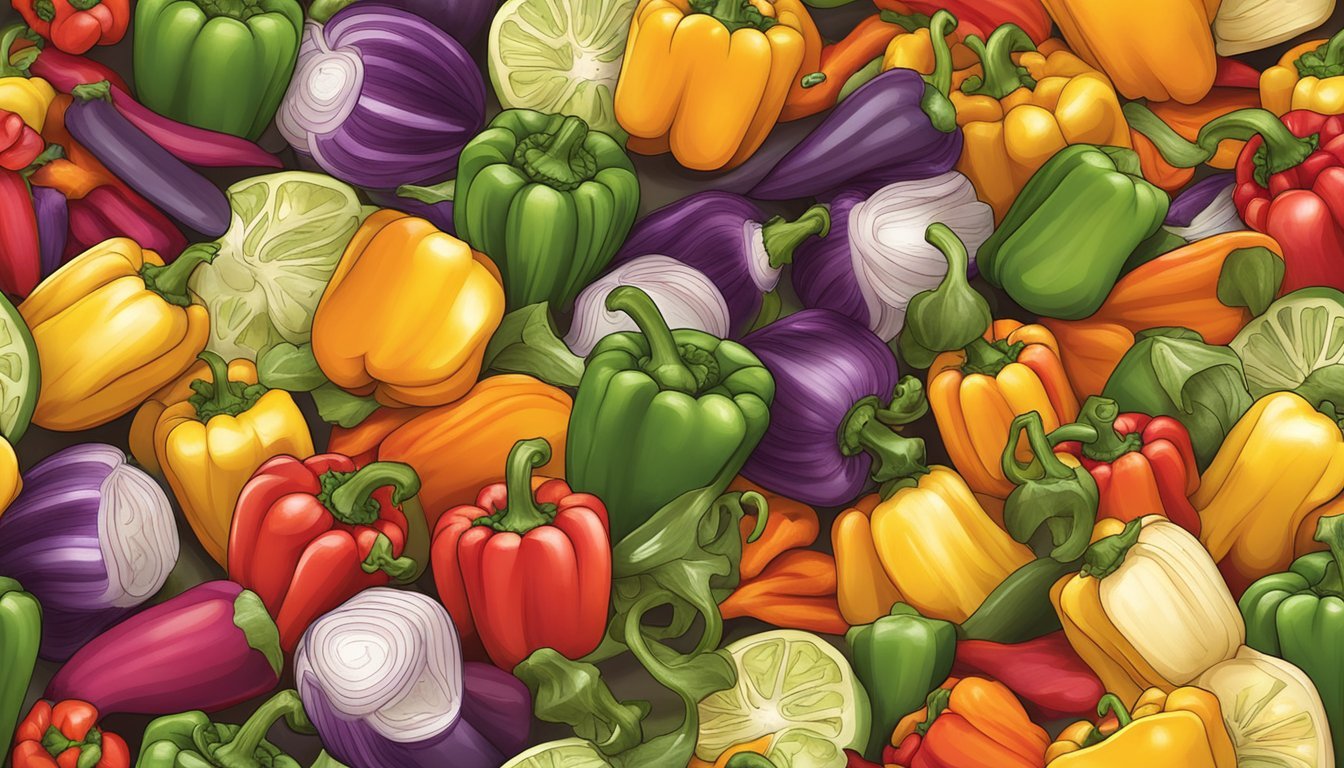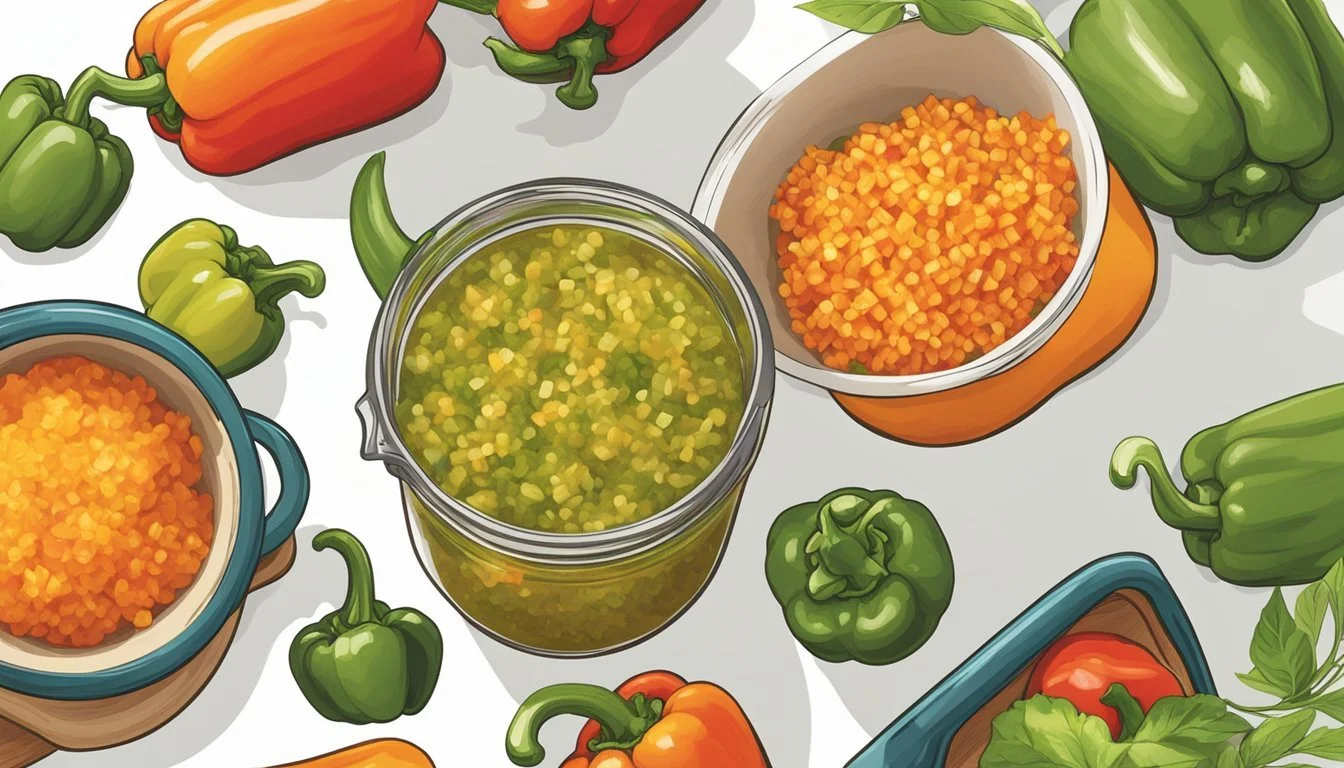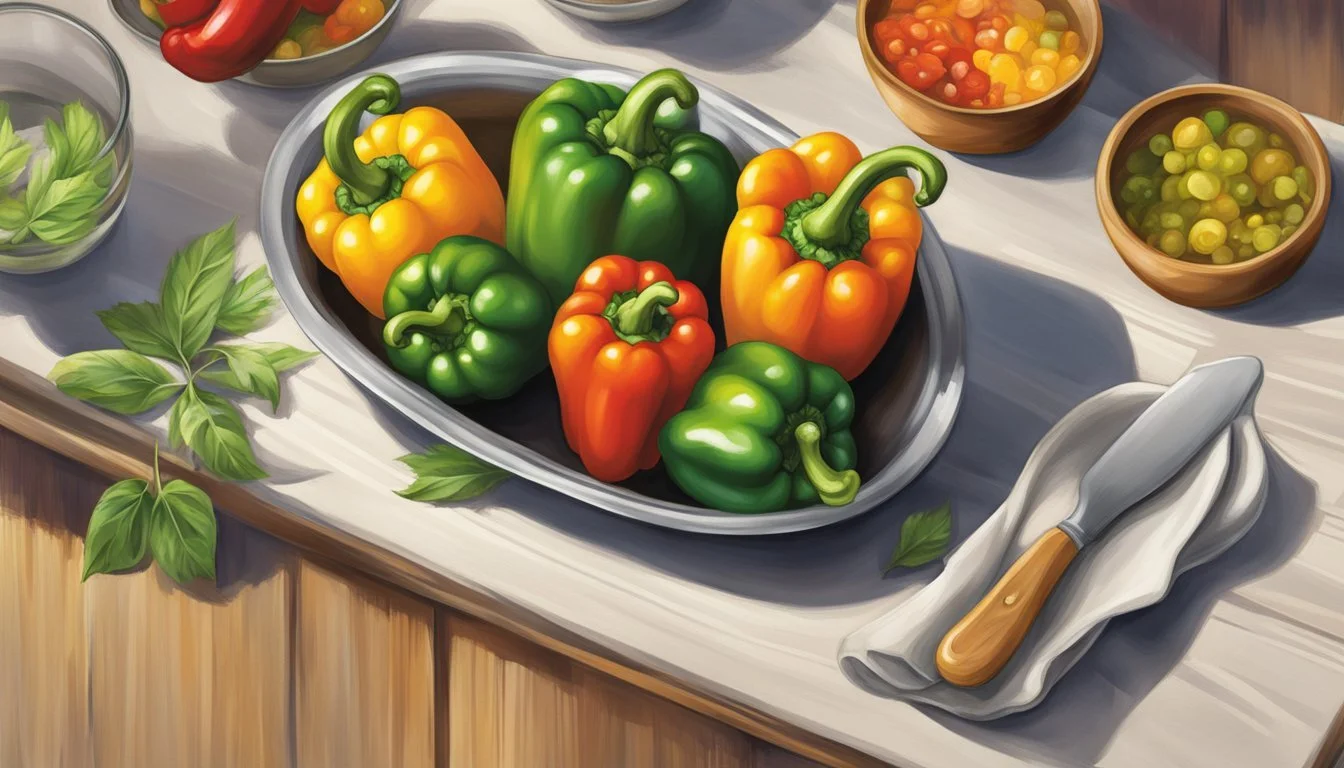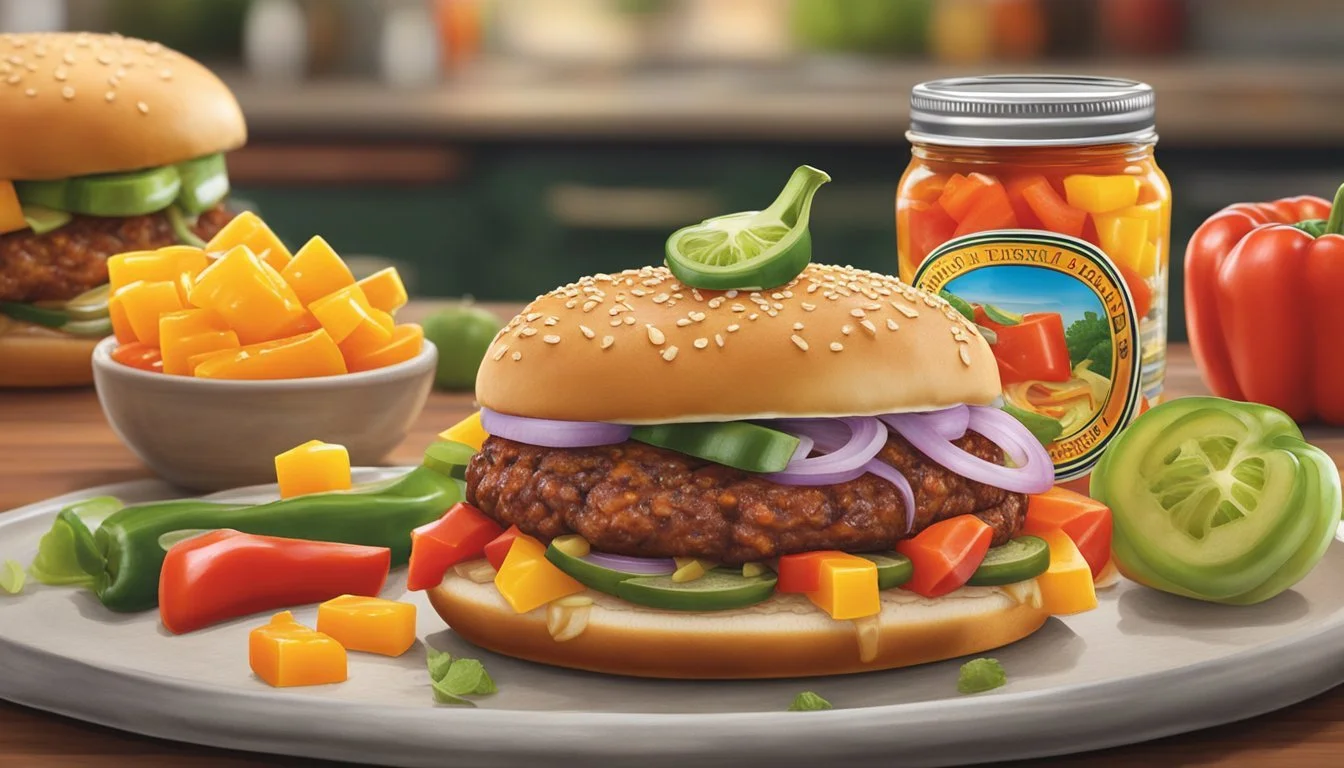Bell Pepper Top Relish
The Perfect Addition to Elevate Your Meals
Bell pepper relish is a delightful condiment that can transform any ordinary dish into a colorful and zesty experience. This versatile topping is made from a medley of bell peppers (What wine goes well with bell peppers?), which not only adds a vibrant array of colors to the palette but also enhances the flavor profile of various recipes. Known for its sweet and tangy taste, bell pepper relish is widely appreciated for its ability to accompany and elevate the taste of meats, sandwiches, and even as a standalone dip.
The preparation of bell pepper relish involves a combination of chopped bell peppers and other ingredients such as onions, vinegar, sugar, and a blend of spices. These ingredients are cooked together to create a balance of sweetness and acidity that tantalizes the taste buds. Its use is not just confined to home cooking; gourmet chefs frequently incorporate bell pepper relish into their dishes to add a burst of flavor.
As relishes gain popularity for their simplicity and the complexity of flavors they bring to dishes, bell pepper relish stands out for its broad appeal. It caters to a wide audience, from those who prefer mild to moderate spiciness to those who enjoy a hint of sweetness in their savory treats. This relish is not just about flavor, but also the texture and aesthetic appeal, making it a culinary trifecta suitable for a variety of dishes.
Overview of Bell Pepper Relish
Bell pepper relish is a vibrant and tangy condiment that enhances a variety of dishes with its sweet and spicy flavors. Typically made from a base of chopped bell peppers, it may include a mix of other vegetables such as onions or garlic. This relish is not just a feast for the palate; its colorful presentation adds visual appeal to meals.
Ingredients:
Bell Peppers (various colors)
Vinegar
Sugar
Onions
Seasonings (e.g., mustard seeds, paprika)
The preparation begins by finely dicing the bell peppers and other vegetables. To balance the sweetness of the peppers, vinegar and sugar are commonly added. The mixture is then cooked down, which allows the flavors to meld together. The cooking process varies, taking anywhere from 15 to 35 minutes, depending on the desired thickness. The result is a condiment that has a chunky texture and a complex flavor profile.
Bell pepper relish is versatile in its use. It can be served as a topping on meats, a flavorful addition to sandwiches, or even as a unique component in appetizers. The relish is usually canned, which preserves its flavor and extends its shelf-life, allowing it to be enjoyed throughout the year.
Moreover, bell pepper relishes are celebrated for their simplicity and the ease with which they can be customized with additional ingredients to suit individual tastes. The basic process of creating this relish remains constant, but the variations are virtually endless, making it a favored item in households and restaurants alike.
Selection and Preparation of Ingredients
Creating a vibrant and zesty bell pepper relish begins with careful selection and preparation of its components. The right blend of bell peppers, supplementary vegetables, and a balance of herbs and spices is critical to developing the perfect flavor profile.
Choosing the Right Bell Peppers
To achieve the ideal texture and sweetness for the relish, one should opt for fresh, firm bell peppers. A mix of red and green bell peppers not only adds a beautiful contrast but also a nuanced flavor. Red bell peppers are sweeter and are fully ripened, whereas green bell peppers have a slightly bitter taste. Look for peppers with taut skins, free from soft spots or blemishes.
Additional Vegetables for Flavor
Alongside bell peppers, the inclusion of onions and garlic imparts depth and a base for the relish’s savory profile. For those desiring a bit of crunch, celery can be finely diced and added to the mix. Each vegetable should be fresh, peeled (if necessary), and finely chopped to ensure even cooking and distribution of flavor.
Herbs and Spices
The herbs and spices unite the relish. Common additions include:
Mustard seeds: Provide a tangy, aromatic quality.
Red pepper flakes: Adjust to desired heat level; use sparingly for a mild relish or more generously for a spicy kick.
Paprika (optional): Offers a smoky flavor when used.
Salt: Enhances the overall flavor profile and should be added according to taste.
These ingredients combine to form the backbone of the relish’s flavor, complementing the natural sweetness and robustness of the peppers and vegetables. Each should be measured and added with precision to achieve a harmonious balance.
Cooking Technique
Perfecting the technique of preparing bell pepper relish involves two critical stages: a careful simmering process for flavor development and reliable canning methods for preservation.
The Art of Simmering
The simmering stage is essential for coaxing out the bell peppers' flavors, melding them harmoniously with oil, vinegar, and additional seasonings. Prep Time often varies, but once the ingredients are in the saucepan, they must be brought to a boil. At this point, reducing the heat to achieve a gentle simmer is crucial. The mixture should simmer for approximately 35 minutes or until the vegetables are tender and the liquid has mostly evaporated. This slow cooking technique allows the flavors to deepen and intensify.
Canning and Storage Methods
For long-term storage, canning the relish is imperative. After the relish is cooked, it should be carefully funneled into sterilized pint canning jars, leaving adequate headspace. Ensure the rim is clean before placing the canning lid and ring on top. Total Time, including processing, depends on jar size and the recipe used. The jars are then placed into boiling water and need to be processed, typically for about 15 minutes to secure a seal for a long shelf life. This method ensures that the relish remains preserved and safe for consumption over an extended period.
Crafting the Perfect Flavor Balance
Creating a bell pepper relish that delights the palate involves balancing acidity and sweetness, as well as modulating the heat and spiciness to taste. The ideal relish is a harmonious blend that can complement a variety of dishes.
Acidity and Sweetness
Acidity is a key component in relish, imparting a refreshing tang that can cut through richness. Vinegars, such as apple cider vinegar for a fruity dimension, white wine vinegar for a milder tang, or red wine vinegar for depth, are standard for introducing acidity. The choice of vinegar affects the overall flavor profile, with balsamic vinegar offering a complex, slightly sweet character.
Balancing the acidity, sweetness often comes from granulated sugar or honey. The amount of sugar or honey used can be adjusted according to how tangy the vinegar is and how sweet the cook prefers their relish. For a well-rounded flavor, the ratio of sugar to vinegar must be carefully considered. A typical start could be one part sugar to one part vinegar, with adjustments made to taste.
Vinegars to consider:
Apple cider vinegar: fruity tang
White wine vinegar: mild tang
Red wine vinegar: deeper tang
Sweeteners to consider:
Granulated sugar: classic sweetness
Honey: rich, natural sweetness
Adjusting Heat and Spiciness
The level of heat in a relish is largely dictated by the choice and quantity of hot peppers included. Jalapeños can provide a medium heat, while other varieties like habaneros or ghost peppers can significantly raise the intensity. It is crucial to carefully select the type of peppers for the desired spice level.
To infuse a hint of spice without overwhelming heat, red pepper flakes or mustard seeds can be added. Mustard seeds introduce a subtle, piquant flavor that complements the sweetness and acidity, while red pepper flakes offer a more pronounced kick. The amount of these spices can be precisely controlled to achieve anything from a mild to a spicy result.
Heat sources to consider:
Hot peppers: choose the variety for desired spice level
Red pepper flakes: adjustable kick
Mustard seeds: subtle spiciness
When crafting bell pepper relish, the key is to taste regularly and tweak the balance of sugar, vinegar, and spices until the flavors meld into a cohesive, zingy topping. Each ingredient should be discernible yet contribute to a seamless whole, enhancing the relish’s compatibility with a wide range of culinary applications.
Serving Suggestions
Bell Pepper Top Relish adds a vibrant and tangy flavor to a wide range of dishes. Its versatility as a condiment or an accompaniment makes it suitable for various culinary applications, enhancing the taste of both proteins and snacks.
Condiment for Proteins
Bell Pepper Top Relish can transform simple proteins into gourmet delights. Here are specific pairings:
Grilled Chicken: A spoonful of relish adds zest to the smoky flavor.
Steak: Complement the richness with the relish's tangy taste.
Burgers: Elevate your burger by topping it with a generous dollop.
Hot Dogs and Bratwurst: A classic pairing that brings a sweet and spicy kick.
Each serving suggestion is tailored to balance the flavors and textures of the protein it accompanies. For an enhanced experience, one can mix the relish with sour cream or yogurt to create a unique sauce.
Accompaniments to Appetizers and Snacks
Bell Pepper Top Relish isn't just for main courses; it works wonders on the snack tray. Consider these combinations:
Cream Cheese: Spread it over crackers and top with relish for a quick, flavorful bite.
Eggs: A tablespoon with scrambled eggs or as a topping for deviled eggs can add color and flavor.
Sandwiches: It can uplift ham or turkey sandwiches with its bright, piquant flavors.
When used as an accompaniment, the relish serves as both a flavor enhancer and a decorative element, making everyday snacks appear more enticing.
Nutritional Information
Bell pepper top relish is not only a vibrant condiment but also a nutritional addition to meals. A single serving of bell pepper relish adds a marginal amount of calories due to the low-calorie nature of bell peppers themselves. For context, a typical bell pepper contains about 31 calories. Therefore, depending on recipe variations, one can anticipate a similar low-calorie count for a serving of relish.
Bell peppers are also a rich source of nutrients. They boast a high content of vitamin C, essential for immune function, with a single bell pepper providing upwards of 150 mg, which is significantly more than the daily recommended value.
Fiber is another key component found in bell peppers. It aids in digestion, helps manage blood sugar levels, and supports heart health. The addition of this relish can modestly increase the fiber content of a meal.
In a standard serving of bell pepper relish, the following nutritional values are typical:
Calories: 5-20 (varies by recipe)
Total Fat: 0-1g
Cholesterol: 0mg
Sodium: Low
Total Carbohydrates: 1-4g
Dietary Fiber: 1-2g
Protein: 0-1g
Vitamin A: Varies
Vitamin C: High
This table represents an estimated breakdown per serving, which usually measures about two tablespoons of relish:
Nutrition Amount Calories 5-20 Fat 0-1g Fiber 1-2g Vitamin C High
Consumers can expect the yield of relish from one whole bell pepper to be around ⅓ to ½ cup, with serving sizes typically around a tablespoon or two. However, exact numbers may vary based on additional ingredients and preparation methods.
Customizing Your Bell Pepper Relish
Bell pepper relish can be easily adapted to suit various dietary needs and personal tastes. By adjusting a few ingredients, one can create a version of this versatile condiment that not only complements a multitude of dishes but also aligns with individual dietary preferences and culinary creativity.
Variations for Dietary Preferences
Sugar Alternatives: For a sweet relish without refined sugar, substitute with equal amounts of honey or even a sugar-free sweetener suitable for cooking.
Vinegar Choices: Use balsamic vinegar for a richer, slightly sweet flavor, or red wine vinegar for a tangier profile.
Oil Options: For a more decadent version, add a drizzle of olive oil to the finished relish.
Creativity with Mix-Ins
Spices: Introduce celery seed to add an earthy tone to the relish.
Fruits: Incorporate finely diced fruits such as apples or pears for a sweet, textural contrast.
Additional Vegetables: Consider adding other finely diced vegetables like onions or jalapeños for extra complexity and heat.
Final Tips and Common Mistakes
Making a bell pepper top relish can elevate any dish with its colorful zest. However, one must be attentive to detail to ensure the relish reaches its full potential.
Tip: The balance of sweetness and acidity is the cornerstone of a great relish. They should always taste their relish and adjust sugar and vinegar as needed, to cater to their palate.
Mistake to Avoid: Overcooking the relish can lead to a mushy texture. They should simmer it just until the peppers are tender but retain some bite.
Canning: If they choose to preserve their relish, they must ensure that canning jars are sterilized to prevent contamination. It's critical that they leave proper headspace in the jars and achieve a good seal after processing.
Common Pitfall: Not processing the relish in a water bath canner, if they are canning, may lead to spoilage. The processing time is crucial for safety.
Food Processor Use: A food processor can drastically cut down preparation time. For a uniform relish, they should pulse the peppers and not overprocess them to a puree.
Mistake Correction Ignoring consistency Aim for evenly-diced pieces Neglecting brine flavor Taste and adjust your brine before adding vegetables Improper canning practices Follow canning guidelines meticulously
Final advice: They should be careful to use recipes with tested proportions especially when canning, as this is crucial for both flavor and safety.








